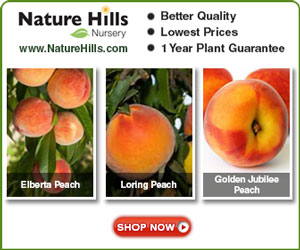Arizona Vegetable & Fruit Gardening For The Arizona Desert Environment.
Pictures, Photos, Images
Descriptions, Information, & Reviews.
We Are Proud Of Our SafeSurf Rating!
| Eggplant, Solanum melongena. Plant. - Photo Taken June 10, 2011 In Yarnell, Arizona. Four Weeks From Planting. Planted With Peruvian Corn. |
|---|
| Eggplant, Solanum melongena. Flower. | Eggplant, Solanum melongena. Vegetable Fruit. Courtesy Wikipedia, the free encyclopedia. |
|---|
We Buy Our Hard To Find Fruit Trees For Yarnell Arizona At Nature Hills Nursery.
We Have Several Nice Fruit Trees Growing In Yarnell, Arizona.
They Will Do Well In Other Similar Elevations In Arizona. ie.. Prescott, Cottonwood, Camp Verde, Sedona.
Cameo & Fuji Apples! Yummm! Click The Nature Hills Nursery Link To View.
 /
/

Eggplant. We wish to thank Wikipedia, the free encyclopedia for some of the information, and images on our page. We share information, images, and donate to Wikipedia. Eggplant originated in India, where it is used in many of their dishes, such as bengan bartha. Eggplant is also the basis for Greek moussaka, French ratatouille, and Italian caponata. Eggplant has gained popularity in the U.S. because of the development of early-maturing varieties that produce fruit over a wider range of temperatures. Eggplant is not only a food eaten worldwide but, it's also versatile. You can add it to soups and pasta dishes or use it as the basis for hearty meatless casseroles and other entrees. It is low in calories and people on diets can substitute it for pasta with the consumption of far fewer calories and carbohydrates. Vegetarians value its rich, deep flavor as an excellent substitute for meat. Modern Eggplants form erect bushes with large, fuzzy leaves and stiff, hard stems. They usually grow 1� to 2 feet high, but some kinds adapted to the South can grow up to 3 or 4 feet. There are a variety of shapes and sizes, some being large, oval & plump to long and slender. Some are the size of a grape. Domestic varieties come in purple, purple-black or white and Asian varieties come in yellow, pink, striped, green, orange, and purplish red. Some varities with oval fruits are: Dusky, Beauty Hybrid, Florida Market (for the South), Early Beauty. With long fruits: Ichiban, & Agora. Eggplants do best in rich, slightly acidic, well-draining soil with compost added. Eggplants need to be spaced about 24 inches apart in rows at least 12 inches apart. Eggplants can be either grown from seed or transplanted. In Arizona, we buy transplants from our local nursery due to the long growing period. The transplants should be set in the garden 2 or 3 weeks after the last frost-free date. Cold shock can kill them. Transplant them in the evening to make the transition easier. If planting seeds, they will need warm soil (temperature between 70 to 80 degrees F) and you should start them indoors, about 8 to 10 weeks before the frost-free date. The baby eggplants need strong sunlight or fluorescent light in late winter. Don't forget, eggplants need heat and humidity to grow well. It's fruit fails to set at temperatures below about 65 degrees Fahrenheit. Eggplants are a very heavy feeders, so side-dressing the plants with well-rotted compost or manure twice a month is encouraged.
This high-yielding Italian heirloom eggplant has a creamy, delicate flavor with no bitterness and a meaty texture, making it a chef favorite. Plump, tear drop-shaped fruits grow 4- to 6-in round. Gorgeous lavender color with streaks of creamy white. 85 DAYS.
A flavor favorite from our trials! Excellent mild, non-bitter, mushroom-like flavor and silky texture. Produces high yields of 5- to 6-in. fruits with ivory-white skin. Prefers cooler conditions than many eggplant varieties, making it a good choice for short-season gardeners. Approx. 70 DAYS.
Enjoy a bumper crop of 8-in. glossy purple fruit with sweet, mild white flesh. Strong plants are tolerant of heat, drought and disease, making Eclipse a breeze to grow in the home garden. Our favorite variety for Eggplant Parmesan! 65 DAYS.
Compact growth habit and highly ornamental appearance make this eggplant perfect for growing in tight spaces and containers. High-yielding plants produce an abundance of deep purple baby fruit that are rich in flavor.While in bloom, the large, lilac and white blooms add to the ornamental appeal. Easy to grow and great for cooking, frying and more. 55 DAYS.
1. Determine the last expected spring frost date for your area. Plan to plant your Eggplants 2 or 3 weeks after the last frost-free date. 2. Cultivate your planting area to break up any hard soil, keeping your rows about 3 feet apart. Pepper varieties prefer well-draining, loose soils with plenty of organic matter. 3. If a soil test has not been taken, make a preplant application of 5-10-10 at the rate of 3 pounds per 100 square feet. Use a starter solution for transplants, and sidedress cautiously after the first fruit reach about the size of a dime using three tablespoons of 33-0-0 per 10 feet of row). Sidedress cautiously until a large number of eggplants are set. Too much nitrogen before fruit set causes all foliage and no fruit. After fruit set, fertilize regularly using a complete fertilizer. Soil pH should be 5.8 to 6.5 for best growth. 4. Purchase certified Eggplants from your local garden center or nursery. 5. Eggplantrs should be spaced 18 to 24 inches apart in the row. Rows should be 24 to 35 inches apart. Select a well-drained, loamy or sandy loam soil for planting. Avoid areas that have had eggplant, tobacco, pepper or Irish potato planted in the previous year. 6. Add about 3 more inches of soil once the eggplants start emerging. Apply a layer of organic mulch to help maintain soil temperatures and to prevent weeds from growing. 7. Water your eggplants once or twice a week when the soil feels dry to the touch. Do Not Spray Water On Your Plants. Eggplants have shallow root systems so they only need a light watering to maintain constant soil moisture. Water sufficiently to moisten the soil to a depth of at least 6 inches. The critical period for moisture is during fruit set and fruit development. Mulching can help to provide uniform moisture, conserve water and reduce weeds. 8. Monitor your eggplants for disease and pest problems. Eggplants grown in by spraying water in Arizona, often suffer from late blight, which can be treated with a fungicide. Control common pests such as snails, potato tubermoth and aphids by sprinkling nontoxic diatomaceous earth around the affected Pepper plants. 9. Eggplants should be ready for harvest in about 100 to 150 days from seed, 70 to 85 days from transplants. Harvest eggplant young before the flesh becomes pithy. When harvesting the fruit, cut the stems instead of pulling, to avoid breaking branches.
Reduce disease problems by:
Pests Of Eggplant In Arizona:
Many disease problems can be avoided by using certified disease-free seed and transplants. Do not use tobacco products near eggplants, since tobacco mosaic virus can be readily spread from tobacco. The two most troublesome diseases of eggplants in the home garden are bacterial wilt and bacterial leaf spot. Other disease problems include Fusarium wilt, Pythium root rot, Cercospora leaf spot, Southern blight and anthracnose (on fruit). Root-knot nematodes can also be a problem.
Beneficial Insects Of Eggplants In Arizona:
Not all insects found in our gardens, & orchards are pests. Many organisms benefit the grower by eating or parasitizing pests in the orchard. These organisms are known as beneficials, natural enemies, or biological control agents. They may be native or introduced from other areas. Beneficial natural enemies (insects and mites) that may occur in our gardens, & orchards could be classified as predators or parasitoids. Predators are those that attack, kill, and feed directly on a pest (prey). Examples of common garden, or orchard predators are ladybeetles, flies, lacewings, wasps, bugs, ants, spiders, and predator mites. Parasitoids are insects that lay eggs on or in a pest (host). The developing larva lives and feeds on the host, parasitizing and eventually killing it. Examples include parasitic wasps such as the egg parasite, Trichogramma sp. Bees are a different class of beneficial insects in the garden or orchard in that they benefit the grower by aiding pollination. It is important that growers are able to recognize, identify, and conserve beneficials in their gardens, & orchards. Conservation of beneficial organisms is a basic tenet of an ecologically sound pest management strategy. Conservation or enhancement of beneficials can be achieved through judicious use of pesticides such as spraying only when and where needed, accurate timing of sprays, and selecting pesticides that are least toxic to beneficials. For Example: Many growers now place colonies of the Blue Orchard Mason bees in their orchards to pollinate their crops for maximum production.
Quick Notes:
Type: The fruit are technically considered berries.
Height: About 24 to 48 inches tall at maturity.
Spread: About 2 - 4 feet wide.
Flowers: Purple and star-shaped with fused petals.
Blooming Time: Spring through Fall.
Fruit: Standard is egg shaped glossy purple black fruit 6-9" long. There are others.
Leaves: Blue-green to dark-green in color, large and broad with scalloped leaf margins. 8 inches long and 5 inches wide. triangle shaped with rounded edges. Underside of the leaf has prickly thorns.
Elevation: 0 - 5,500 feet.
Hardiness:
Soil pH requirements:
Light: Full Sun.
Habitat: Mulched areas. Well-drained soil with a 5.5 and 6.5 pH.
Native: Native to India and China.
Miscellaneous: Photos Taken June 10, 2010 In Yarnell, Arizona. Hardy Temp: 50�F. Prefers70�F and 85�F. Doesn't Set Fruit below 60�F.
|
Here Are Some Links To The Very Best & Most Popular Items Sold On Amazon.Com
To Learn More! Click The Links Below. No Obligation, Of Course!



